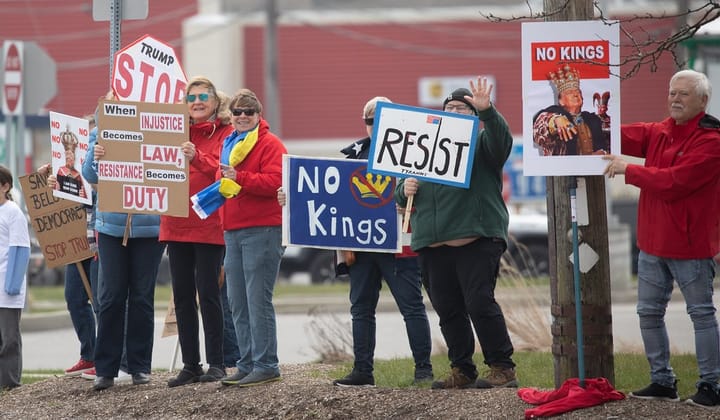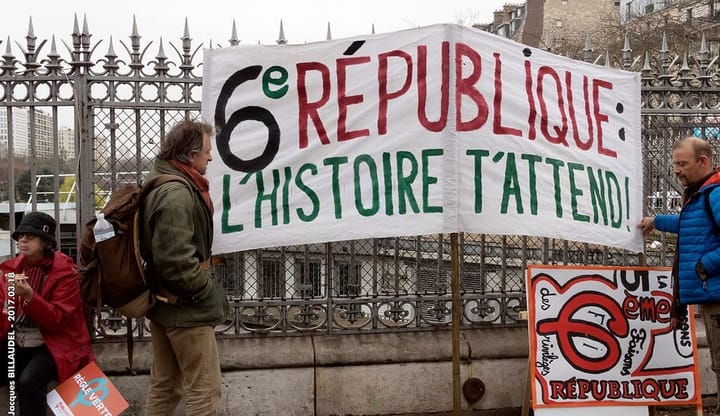Wrecking Ball
This week: an act of political demolition.

“He knows nothing; and he thinks he knows everything. That points clearly to a political career.”
― George Bernard Shaw, Major Barbara
Merriam-Webster Dictionary defines grand in a number of ways. For those of a political bent, almost all of the definitions are bound to make one think of one particular person:
grand\ˈgrand \ adjective 1 a : having more importance than others : foremost; b : having higher rank than others bearing the same general designation: the grand champion
2 a : inclusive, comprehensive the grand total of all money paid out; b : definitive, incontrovertible grand example
3 : chief, principal the grand ballroom
4 : large and striking in size, scope, extent, or conception: grand design
5 a : lavish, sumptuous a grand celebration; b : marked by a regal form and dignity; c : fine or imposing in appearance or impression: sported a grand mustache; d : lofty, sublime writing in the grand style
6 a : pretending to social superiority : supercilious; b : intended to impress: a person of grand gestures
7 : very good : wonderful a grand time
Number six is particularly relevant. Up to now, our presidents, for the most part, at least tried to pretend a connection to the Common Man. And that’s because we as a people expected to elect from among us one to lead us much as we would lead ourselves, if we could.
And we’ve done well having gone that way. Our first president and the Father of Our Country, George Washington, was something of a patrician, as were most of the early presidents, at least until Andrew Jackson came along.
But our country was saved by two presidents, Abraham Lincoln and Ulysses S. Grant, from hardscrabble backgrounds, and most of our most successful presidents since then started out from humble beginnings. The ones who didn’t kept those who grew up less privileged than them front of mind (and it’s fair to call it an American variant of noblesse oblige).
Even during the Nixon Administration, when the concept of the imperial presidency began to take hold in our political consciousness, the empire was one of command over the law rather than wealth and status. Nixon himself was socially awkward, never quite as comfortable in the presence of Republican old money as he was with the business class.
Maybe that’s why we didn’t recognize the growing danger, or at least enough of us didn’t — true conservatives can rightfully claim they did, true libertarians even more so. Expanding tyranny can be tough to see when there is abundant food on the table and a healthy account at the bank.
And when presidents are people of good will who are truly trying their best for the American people, as they see it, it can be impossible. Over time, we came to reflexively expect our presidents to do something, especially in times of crisis, but always in terms of stewardship of our economy and the maintenance of our political stability.
We even went so far as to come to habitually demand the president be a leader who would unify the country — even though we’re a famously difficult people to lead, and we’ve never been anything close to unified. We’re a rowdy, fractious nation if ever there was one.
We’re also a nation committed to certain principles, as embodied first in the Declaration of Independence as a statement of liberty, and second in the Constitution as a blueprint for a government which would preserve, protect and defend that liberty.
We vindicate our individual rights through due process and the equal protection of the laws. We legitimate the exercise of political power through the grant of limited authority in the Constitution and the consent of the governed as expressed in every election.
At no point to we sacrifice one to the other, or both to a tyrant.
Which is the real point of the opposition to the current president’s sudden and impulsive destruction of the East Wing of the White House to make room for a massive, privately-funded gilded ballroom. We instinctively see it as just plain wrong — or at least most of us do.
And that’s because we expect a certain degree of restraint in our presidents. There have been previous renovations to the White House, some very extensive, throughout its history. Some of the work has been privately funded.
But all of it has been done according to a process, often lengthy, with some kind of oversight, some procedure to include the relevant stakeholders, some respect for the White House as the People’s House and a national landmark (which is a legal designation, by the way).
As a technical matter, the president probably has the authority to act so unilaterally to alter the physical premises of the White House. The loopholes in the law are big enough to drive at least a golf cart through.
Yet, we can’t help but recoil and the extremity of what the current president is doing. We have seen many presidents, including those of a much higher moral character than the current occupant of the White House, stretch the bounds of presidential authority to the limit, and arguably, beyond. But we’ve never seen one run so roughshod over the traditions, norms and standards we’ve come to associate with the office.
What we think of as the Constitution goes beyond simply the words on the paper. It includes what we often call the spirit of the laws: the intent behind what we’ve codified. Our national project was to use the law to create limited government; the current president is bent on using the law to exercise unlimited power.
Where it will ultimately lead is anyone’s guess. But there can’t be any doubt any longer (and there shouldn’t have been a doubt to begin with) where the president wants to go. In his mind, force equals power. He’s taking a wrecking ball to the very notion of restraint and destroying any limits to his authority by using the law against itself.
He doesn’t care to govern. He wants to rule.
And given how much we’ve departed from the original conception of the presidency and the fundamental spirit of the Constitution over the last few decades, he just might get there.
Addendum
Here are two articles on White House renovations:
White House Renovations Over the Years: Trump's Changes Compared to Past Presidents - Newsweek
🏛️ East Wing Timeline: Key Milestones
🔹 1942 – Original Construction
- Built during Franklin D. Roosevelt’s presidency.
- Purpose: Provide office space, a cloakroom, and cover for an underground bomb shelter amid WWII tensions.
- Functionally expanded the White House’s capacity during wartime.
🔹 1977 – First Lady’s Office
- Became the official workplace of the First Lady starting with Rosalynn Carter.
- Housed staff for social events, correspondence, and public initiatives.
🔹 2025 – Demolition & Reconstruction
- President Donald Trump ordered the complete demolition of the East Wing to build a 90,000-square-foot ballroom, funded by $300 million in private donations.
- The new structure is designed to host state functions and diplomatic events.
- The administration claims the project will modernize the entire East Wing, though critics argue it bypasses historic preservation protocols.
[Timeline created using Microsoft Copilot.]
Thank you for reading this inaugural edition of the new Sunday Wire. With the Modern Whig Institute’s reconstruction — fancy that, an irony of ironies — now complete, we’ll publish this feature every Sunday morning at 10 a.m. from now on.
We did a little experimenting with this one, which made us a little late. Our apologies for that. But that’s what experiments are for: to find out what works, and what doesn’t. In the future, we’re going to make this quite a bit longer, so expect a decent long read to go with your Sunday morning coffee.
To get the Sunday Wire and the other content of the Modern Whig Leader delivered to your inbox, simply hit the Subscribe button and leave us your name and email address.
To join the Modern Whig Institute and support our mission of civic research and education, click here.
Kevin J. Rogers is the executive director of the Modern Whig Institute. He can be reached at director@modernwhiginstitute.org.


